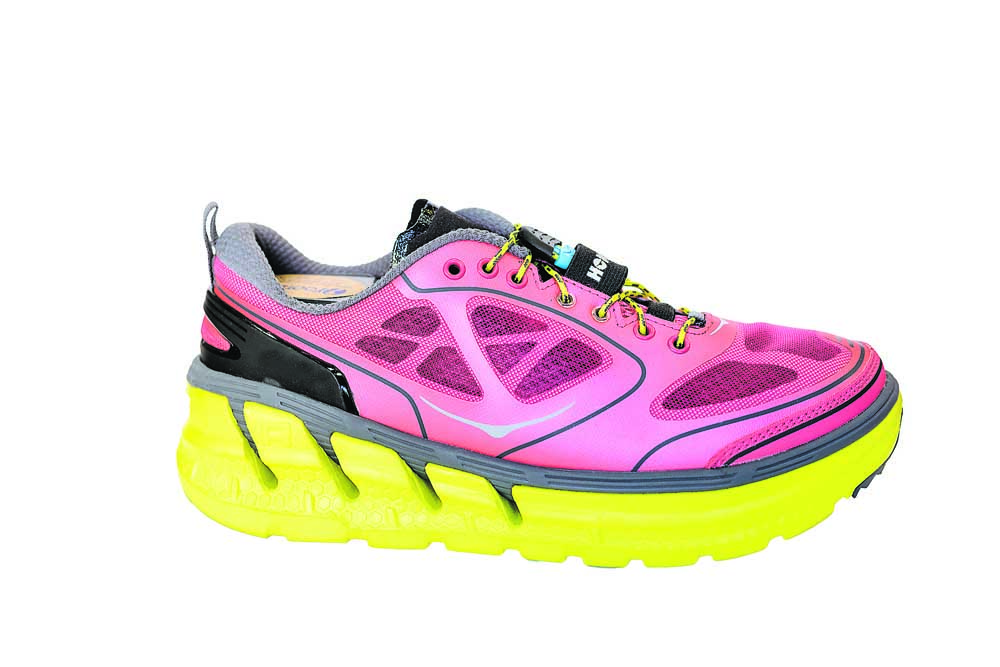Shoe evolution
Published 12:00 am Saturday, July 12, 2014

- Hoka One One
Why I ran (and walked) the 15-mile Smith Rock Ascent trail race on June 14, absolutely the most grueling trail race I’ve ever run, is still not clear to me. Starting in Smith Rock State Park, the race climbed to the top of Gray Butte, an elevation gain of 3,000 feet, and circled back to the park on mostly single-track trails.
While questioning my sanity during the run, I also had two things on my mind. One: Will I survive? And two: Will I see anyone wearing Hoka running shoes, the newest hot trail running shoe in Central Oregon?
Trending
Sure enough, on the screaming descent from Gray Butte, I fell in behind a lithe young woman (whose quadriceps were not on fire like mine) wearing Hokas. Between gasps of air, I asked her how she liked them.
“I love them,” she said without a hint of breathlessness. “I also have a pair of Montrail’s, but I like my Hokas better, the extra cushioning really softens these downhills and my legs recover much faster.”
Hobbling around the finish line after the race I noticed a number of other runners with Hokas. While I sat in the cool grass, they walked around looking like they could run another 15 miles.
Is “oversized” midsole cushioning the new running shoe technology trend?
A few decades ago running shoe technology revolved around controlling the motion of the foot. Shoe companies designed shoes to control overpronation (excessive inward roll of the foot on impact) and supination (excessive outward roll).
Then along came the “cushioning” systems — Nike Air, Asics Gel, Adidas’ Dellinger Web, and several others. Intended to lessen impact to the musculoskeletal system while prolonging the useful life of the shoe, all of these inventions pushed the innovation bar (and retail prices) higher.
Trending
Then, within the last decade or so, a trend toward allowing the foot to move more “freely” emerged so that the foot moved with a runner’s natural gait. Shoes were introduced with softer midsoles, glove-like uppers, and outsoles that allowed the foot to plant, flex and roll as nature intended.
And then there were the gimmicks marketed as technological improvements. Remember Skechers rocker-bottom shoes that were “scientifically designed” to tone your butt?
And let’s not forget the more recent trend — minimalist and barefoot running that caught fire with the release of Chris McDougall’s 2009 best-selling book “Born to Run: A Hidden Tribe, Superathletes, and the Greatest Race the World Has Never Seen.”
McDougall’s assertion is that modern cushioned running shoes are a major cause of running injuries and that, after switching to the thin sandals worn by Tarahumara Indian Tribe runners in Mexico, he was able to overcome his previous running injuries.
Shoe company designers and product managers jumped on the bandwagon, racing to see who could get to market first with the least-cushioned, lowest profile, naturally-moving running shoe they could make.
Teague Hatfield, owner of the FootZone, a specialty running store in downtown Bend, has been watching these trends for 19 years.
“There’s not one shoe on the wall that wasn’t affected when ‘Born to Run’ came out. There’s not one shoe that’s the same after the whole minimalism trend came out.”
Vibram USA, best known for supplying long-wearing rubber compounds for outsoles, beat everyone to market with its “FiveFingers” running shoes.
Runners are a savvy bunch of athletes who know, from having purchased a lot of running shoes, what works for them and what doesn’t.
“The problem with minimalism is that everyone wanted to see how little cushioning they could get away with. That’s the problem — people began to say, ‘No, I really do need cushioning,’” Hatfield said.
So the running shoe technology pendulum began swinging once again.
“For years, shoes trended toward the overbuilt side of things. Now (shoe companies are) coming back to, ‘Oh no, ride really matters, possibly more than anything else,” Hatfield said.
About three years ago, a small startup called Hoka One One (pronounced “O-nay, O-nay”) gave the pendulum a big push by introducing running shoes with oversized midsole cushioning, wide body design, and a pronounced “rocker” profile (allowing the shoe to roll easily from heel to toe) enhancing the “ride.” And the shoes were much lighter than any other shoes on the market.
Trail running-crazy Central Oregon embraced them immediately. So was all that research about stability, motion control, natural motion, etc., being debunked?
Not really, says Scott White, owner of Fleet Feet Sports on Northwest Galveston Avenue in Bend.
“Hoka, while being a niche brand, has been a very hot brand. They are ultra-wide and ultra-cushioned to gain stability on trails,” he said.
Jim Van Dine, president of Hoka One One, believes his company is forging a new technological path.
“We definitely view our technology as revolutionary. It was designed from scratch — with biomechanical and athlete testing, and no other brand’s technology was referenced during development. None of the other ‘technologies’ are similar — despite some aesthetic similarities in some cases.”
Trail running shoes make up about 30 percent of FootZone’s business. Nationally, it’s about 2 percent for retailers. Easy access and the abundance of trails in Central Oregon make this area a runner’s mecca. So it’s no wonder that another trend is the “hybrid” shoe, one shoe that works well for both roads and trails.
“The hybrid shoe, one that’s not extremely aggressive lug-wise, but it’s also good for trail running — that’s a trend as well,” White said.
Another trend with serious runners is having diversity within their shoe collection. Just as runners diversify their daily training, they’re also using different shoes for different events throughout the week.
“Most runners don’t thrive being in only one shoe. Most people believe now that we need a bit of diversity in our running shoes, not wearing the same pair again and again,” Hatfield said.








